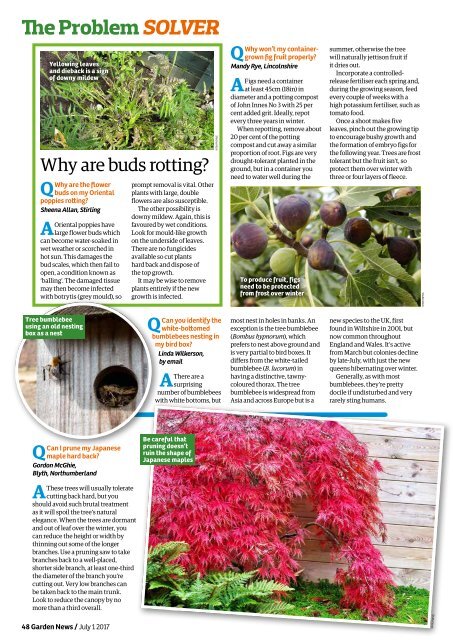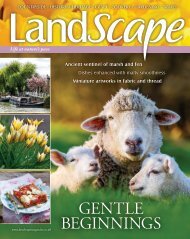Create successful ePaper yourself
Turn your PDF publications into a flip-book with our unique Google optimized e-Paper software.
The Problem SOLVER<br />
Yellowing leaves<br />
and dieback is a sign<br />
of downy mildew<br />
Why are buds rotting?<br />
Why are the flower<br />
Q buds on my Oriental<br />
poppies rotting?<br />
Sheena Allan, Stirling<br />
Oriental poppies have<br />
A large flower buds which<br />
can become water-soaked in<br />
wet weather or scorched in<br />
hot sun. This damages the<br />
bud scales, which then fail to<br />
open, a condition known as<br />
‘balling’. The damaged tissue<br />
may then become infected<br />
with botrytis (grey mould), so<br />
Tree bumblebee<br />
using an old nesting<br />
box as a nest<br />
prompt removal is vital. Other<br />
plants with large, double<br />
flowers are also susceptible.<br />
The other possibility is<br />
downy mildew. Again, this is<br />
favoured by wet conditions.<br />
Look for mould-like growth<br />
on the underside of leaves.<br />
There are no fungicides<br />
available so cut plants<br />
hard back and dispose of<br />
the top growth.<br />
It may be wise to remove<br />
plants entirely if the new<br />
growth is infected.<br />
Can you identify the<br />
Q white-bottomed<br />
bumblebees nesting in<br />
my bird box?<br />
Linda Wilkerson,<br />
by email<br />
There are a<br />
A surprising<br />
number of bumblebees<br />
with white bottoms, but<br />
Shutterstock<br />
Sheena Allan<br />
Why won’t my containergrown<br />
fig fruit properly?<br />
Q<br />
Mandy Rye, Lincolnshire<br />
Figs need a container<br />
A at least 45cm (18in) in<br />
diameter and a potting compost<br />
of John Innes No 3 with 25 per<br />
cent added grit. Ideally, repot<br />
every three years in winter.<br />
When repotting, remove about<br />
20 per cent of the potting<br />
compost and cut away a similar<br />
proportion of root. Figs are very<br />
drought-tolerant planted in the<br />
ground, but in a container you<br />
need to water well during the<br />
To produce fruit, figs<br />
need to be protected<br />
from frost over winter<br />
most nest in holes in banks. An<br />
exception is the tree bumblebee<br />
(Bombus hypnorum), which<br />
prefers to nest above ground and<br />
is very partial to bird boxes. It<br />
differs from the white-tailed<br />
bumblebee (B. lucorum) in<br />
having a distinctive, tawnycoloured<br />
thorax. The tree<br />
bumblebee is widespread from<br />
Asia and across Europe but is a<br />
summer, otherwise the tree<br />
will naturally jettison fruit if<br />
it dries out.<br />
Incorporate a controlledrelease<br />
fertiliser each spring and,<br />
during the growing season, feed<br />
every couple of weeks with a<br />
high potassium fertiliser, such as<br />
tomato food.<br />
Once a shoot makes five<br />
leaves, pinch out the growing tip<br />
to encourage bushy growth and<br />
the formation of embryo figs for<br />
the following year. Trees are frost<br />
tolerant but the fruit isn’t, so<br />
protect them over winter with<br />
three or four layers of fleece.<br />
new species to the UK, first<br />
found in Wiltshire in 2001, but<br />
now common throughout<br />
England and Wales. It’s active<br />
from March but colonies decline<br />
by late-<strong>July</strong>, with just the new<br />
queens hibernating over winter.<br />
Generally, as with most<br />
bumblebees, they’re pretty<br />
docile if undisturbed and very<br />
rarely sting humans.<br />
Shutterstock<br />
Can I prune my Japanese<br />
Q maple hard back?<br />
Gordon McGhie,<br />
Blyth, Northumberland<br />
These trees will usually tolerate<br />
A cutting back hard, but you<br />
should avoid such brutal treatment<br />
as it will spoil the tree’s natural<br />
elegance. When the trees are dormant<br />
and out of leaf over the winter, you<br />
can reduce the height or width by<br />
thinning out some of the longer<br />
branches. Use a pruning saw to take<br />
branches back to a well-placed,<br />
shorter side branch, at least one-third<br />
the diameter of the branch you’re<br />
cutting out. Very low branches can<br />
be taken back to the main trunk.<br />
Look to reduce the canopy by no<br />
more than a third overall.<br />
Be careful that<br />
pruning doesn’t<br />
ruin the shape of<br />
Japanese maples<br />
48 <strong>Garden</strong> <strong>News</strong> / <strong>July</strong> 1 2017<br />
Shutterstock

















